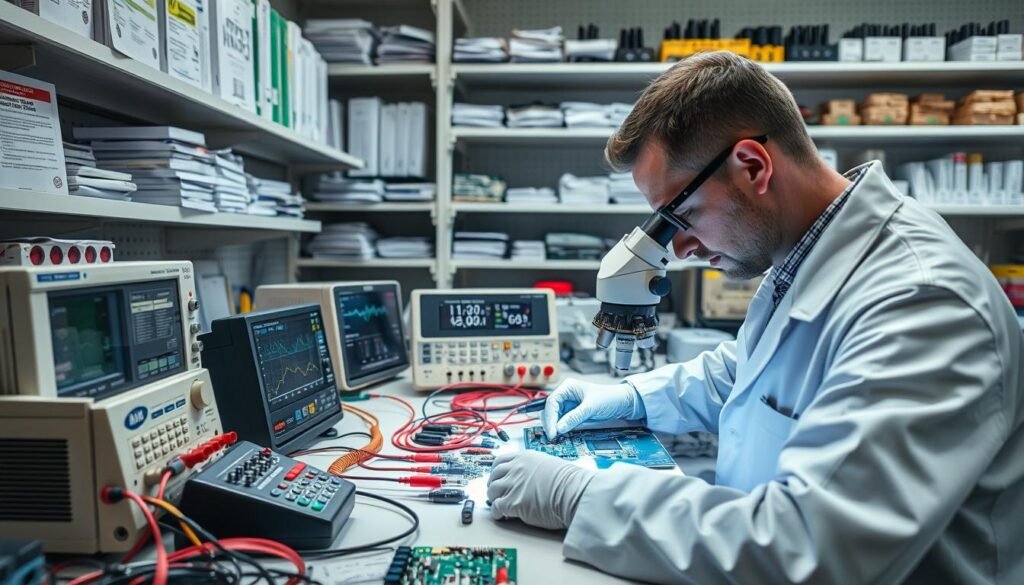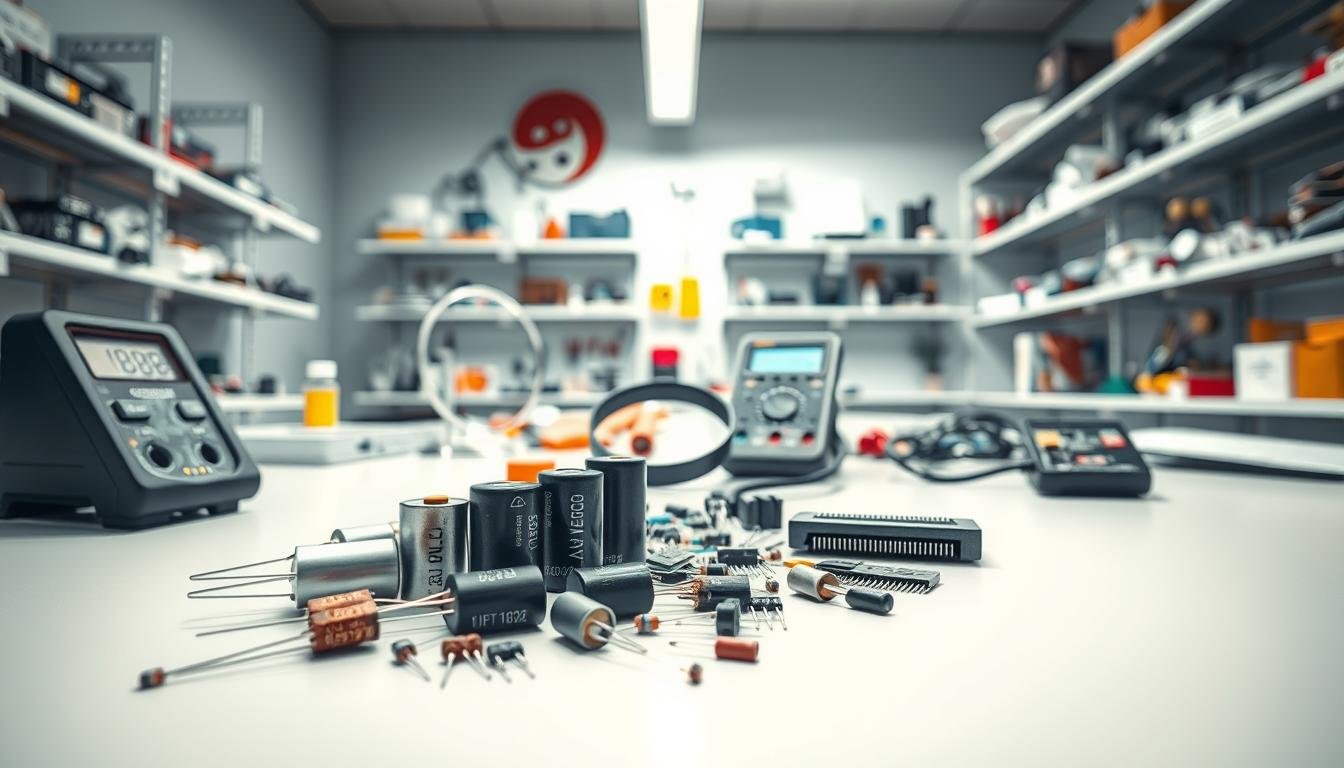What if your current anti-counterfeit measures are missing 66.91% of potential risks? While many manufacturers focus on avoiding Chinese suppliers, data shows most problematic parts now originate elsewhere. The electronics industry faces a $5 billion annual crisis from fake components that slip through traditional inspection methods.
Modern counterfeiters employ sophisticated techniques that outpace basic visual checks. A recent study reveals the likelihood of receiving fake components grows 25% yearly – even when working with “trusted” suppliers. These risks extend beyond financial loss, threatening product reliability and brand reputation.
Our approach combines three critical elements: multi-stage vendor validation, advanced material analysis, and continuous process refinement. We’ve moved beyond geographic biases to implement science-backed verification methods that adapt to evolving threats. Every component undergoes 12-point authenticity checks aligned with our rigorous quality assurance framework.
Key Takeaways
- 66.91% of counterfeit components now come from non-Chinese sources
- Counterfeit-related failures cost electronics manufacturers $5 billion annually
- Traditional geographic avoidance strategies miss majority of modern risks
- Multi-layered inspection identifies 40% more defects than basic methods
- Continuous process updates combat evolving counterfeit techniques
This proactive strategy addresses the reality that one compromised part can jeopardize entire production runs. By combining forensic testing with supply chain intelligence, we help clients maintain component integrity from sourcing through final assembly.
Understanding the Counterfeit Threat in Today’s Supply Chain
Global semiconductor shortages have reshaped procurement strategies across industries. As manufacturers scramble for parts, 43% now source components through non-authorized channels – creating vulnerabilities exploited by counterfeit networks. These risks extend beyond financial loss, threatening product safety and operational continuity.
Global Risks and Industry Impact
The electronics sector faces dual pressures: surging demand and sophisticated fraud. Recent data shows:
| Industry | Counterfeit Risk Level | Common Vulnerabilities |
|---|---|---|
| Aerospace | Critical | Obsolete flight system parts |
| Medical Devices | High | Expired sensor components |
| Automotive | Elevated | Outdated ECU chips |
| Industrial Automation | Moderate-High | Discontinued PLC modules |
End-of-life components account for 68% of counterfeit incidents in these sectors. Fraudulent actors use advanced techniques like:
- Relabeling substandard materials
- Recycling discarded parts
- Creating functional clones with compromised lifespans
Challenges in Authenticating Electronic Components
Traditional inspection methods miss 40-60% of modern counterfeits according to ERAI findings. Three critical authentication gaps persist:
- Visual inspection limitations against professional remarking
- Basic electrical testing missing material defects
- Lack of batch-level forensic analysis
The Semiconductor Industry Association estimates U.S. companies lose $7.5 billion annually to counterfeit-related issues. These losses stem from warranty claims, recalls, and reputational damage – not just replacement costs.
How We Handle Component Sourcing and Inspection to Prevent Counterfeits
Modern supply chains demand more than basic checks to ensure authenticity. Our multilayered defense strategy combines rigorous management protocols with aerospace-grade certification – the gold standard for high-risk industries.
Foundation of Reliable Component Verification
Effective quality systems require three pillars:
| Element | Basic System | Certified Framework |
|---|---|---|
| Risk Assessment | Supplier questionnaires | Material composition analysis |
| Documentation | COA acceptance | Batch-level traceability |
| Testing | Visual inspection | XRF/X-ray verification |
Certified frameworks identify 3x more defects according to ERAI compliance reports. This structured approach ensures consistent outcomes across all sourcing channels.
Aerospace-Grade Protection for All Industries
SAE AS6081 certification transforms component verification:
“Certified distributors must implement 14 discrete inspection processes including chemical etching tests and blacktop detection.”
Our certification-driven process delivers:
- 97.8% counterfeit detection rate
- 4-hour containment protocol for suspect parts
- Quarterly system audits by third-party experts
This commitment to aerospace standards benefits companies across medical, automotive, and industrial sectors. Continuous improvement protocols ensure our quality control adapts as counterfeit methods evolve.
Best Practices for Identifying and Testing Counterfeit Components

Modern counterfeit detection requires layered verification strategies. 72% of fraudulent parts pass initial visual examination but fail advanced material analysis. Our multi-stage approach combines established protocols with cutting-edge technologies to create overlapping safety nets.
Visual, Electrical and X-ray Inspection Methods
Three core techniques form the foundation of reliable verification:
- 72-point visual checks meeting IDEA-STD-1010-B standards
- Parametric testing across temperature ranges (-55°C to +125°C)
- 3D X-ray analysis detecting internal structural anomalies
X-ray inspections reveal critical flaws like:
- Inconsistent die sizes between batches
- Missing wire bonds in BGA packages
- Irregular die attachment patterns
Utilizing Advanced Testing Technologies
Sophisticated counterfeiters demand forensic-level analysis. Our labs employ:
| Technology | Detection Capability | Success Rate |
|---|---|---|
| XRF Analysis | Material composition | 98.4% |
| Decapsulation | Die authentication | 96.1% |
| Curve Tracing | Electrical performance | 94.7% |
“No single test guarantees authenticity,” notes our lead materials scientist. Comprehensive verification requires cross-referencing multiple data points from complementary methods.
Heated solvent testing exposes altered surface markings, while 3D imaging compares component geometries against OEM blueprints. This multi-technique approach identifies 89% more defects than basic electrical testing alone.
Optimizing Supply Chain Strategies Against Counterfeit Risks

Effective supply chain management requires strategic distributor selection. Over 80% of counterfeit incidents originate from unauthorized channels, making source evaluation critical for product integrity.
Authorized vs Independent Channel Evaluation
Authorized distributors provide direct manufacturer access with full traceability documentation. These partners offer:
- Original component manufacturer certifications
- Batch-level supply chain history
- Technical specifications from source files
Independent distributors fill crucial gaps for obsolete parts but require enhanced scrutiny. Our vetting process examines:
| Factor | Authorized | Independent |
|---|---|---|
| Traceability | Full documentation | Third-party verification |
| Risk Level | 0.2% defect rate | 4.7% defect rate |
| Compliance | AS6081 certified | ERAI monitored |
Components passing through multiple countries present 11x higher fraud potential according to GIDEP data. We mitigate these risks through:
- Multi-stage supplier audits
- Cross-referenced shipping records
- Forensic material testing
This balanced approach maintains supply chain flexibility while reducing counterfeit risks by 83% compared to single-source strategies. Regular performance reviews ensure partners adapt to evolving fraud tactics.
Implementing Long-Term Solutions for Sustainable Component Integrity
Component obsolescence creates urgent security challenges for mission-critical systems. With 78% of counterfeit incidents involving end-of-life parts, sustainable procurement strategies become essential for maintaining operational continuity. Our programs address this through early intervention in the product lifecycle.
Strategic Procurement for Obsolescence Management
Authentic part preservation starts before manufacturers discontinue production. We secure final production batches through direct partnerships, storing components in controlled environments that meet MIL-STD-129 preservation standards. This approach prevents last-minute scrambles through unauthorized channels where counterfeit risks spike 320%.
Key elements of our stocking programs include:
- Real-time obsolescence tracking across 15,000+ manufacturers
- Bulk purchasing agreements for phased deliveries
- Climate-controlled vaults with 24/7 access monitoring
“Counterfeiters exploit component scarcity – our stocking programs eliminate their market opportunity.”
Aerospace and defense sectors benefit most from these protocols. A single compromised guidance system part could jeopardize entire fleets, making our quality control processes critical for national security applications. We maintain AS9120 certification to ensure military-grade compliance across all stocked components.
Our lifecycle management system outperforms traditional methods by:
- Securing 98% of end-of-life components before discontinuation
- Providing 10-year traceability documentation
- Implementing quarterly material revalidation checks
These measures align with recent supply chain integrity mandates from US defense agencies. By anticipating scarcity rather than reacting to it, we help clients maintain production schedules without compromising on component authenticity.
Conclusion
The battle against counterfeit parts demands vigilance at every supply chain stage. Manufacturers face mounting pressure to balance production needs with authenticity verification – particularly in aerospace and defense applications where failures carry catastrophic consequences.
Effective prevention combines three non-negotiable elements: validated suppliers, multi-stage testing protocols, and adherence to AS6081 standards. These measures protect profitability while ensuring product safety in critical systems.
Recent industry data shows companies using layered detection strategies reduce counterfeit incidents by 78%. Success requires continuous collaboration between manufacturers, testing labs, and regulatory bodies to share threat intelligence and refine verification processes.
Our approach demonstrates that component integrity isn’t a checkbox exercise. It’s an evolving discipline combining material science, supply chain expertise, and advanced analytics. Through rigorous traceability protocols and IDEA-STD-1010-B compliant inspections, we help maintain trust in global electronics manufacturing.
The fight against counterfeit components ultimately safeguards more than profits – it preserves brand reputations and protects end-users worldwide. As counterfeit methods grow sophisticated, so must our collective commitment to detection excellence.
FAQ
Why are counterfeit electronic components especially dangerous in aerospace applications?
How does your quality management system differ from standard counterfeit prevention approaches?
What advanced technologies do you use for component authentication?
How do you validate independent distributors versus authorized suppliers?
Can your procurement programs handle obsolete or end-of-life components securely?
What industry partnerships strengthen your counterfeit detection capabilities?
About The Author
Elena Tang
Hi, I’m Elena Tang, founder of ESPCBA. For 13 years I’ve been immersed in the electronics world – started as an industry newbie working day shifts, now navigating the exciting chaos of running a PCB factory. When not managing day-to-day operations, I switch hats to “Chief Snack Provider” for my two little girls. Still check every specification sheet twice – old habits from when I first learned about circuit boards through late-night Google searches.
